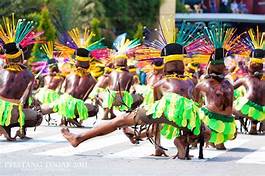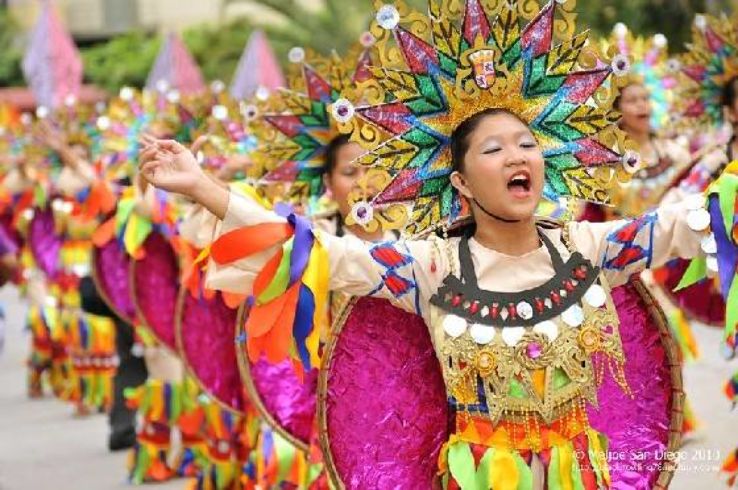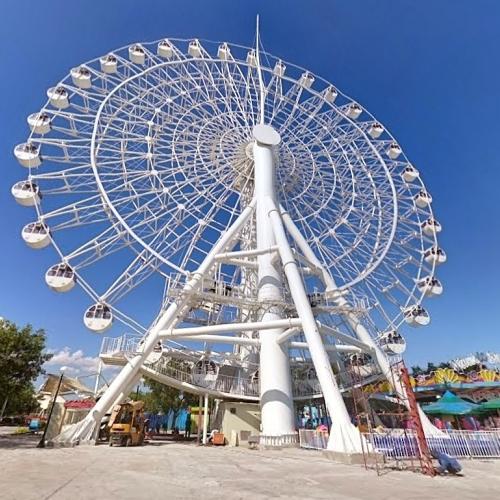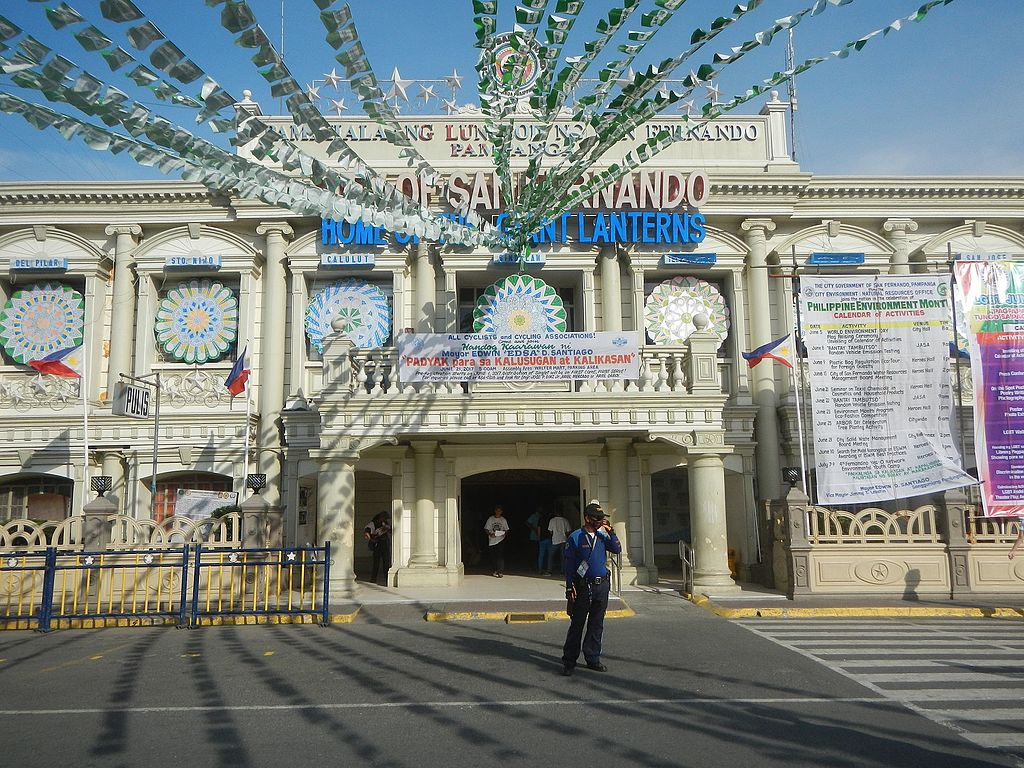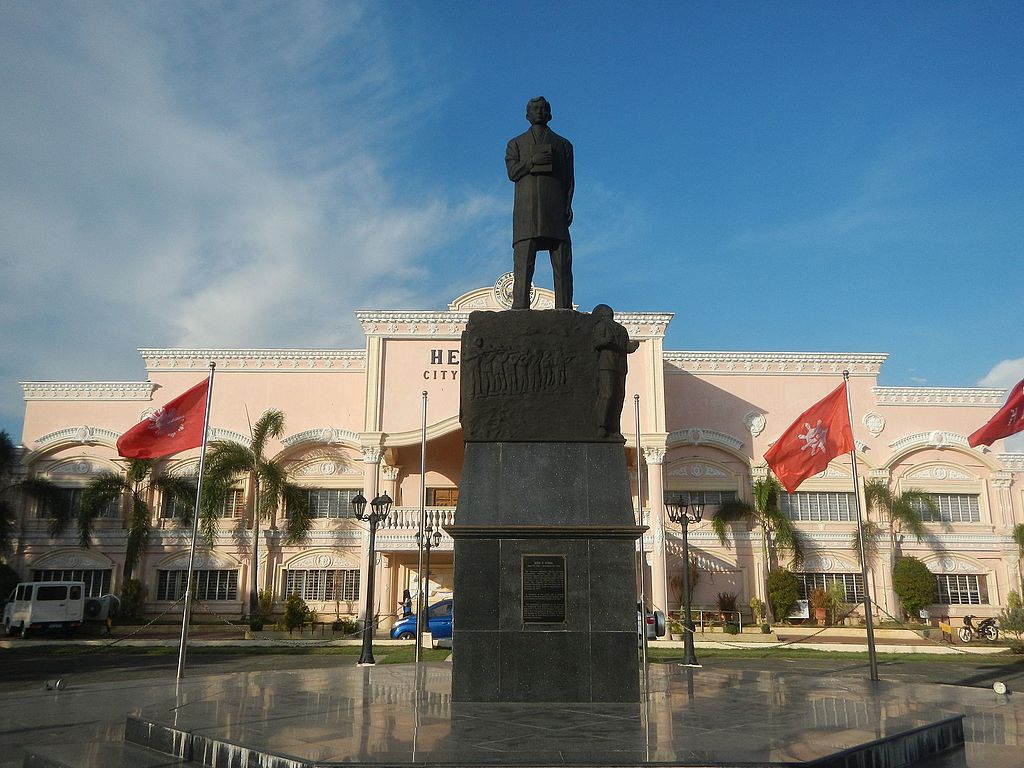The city of San Fernando is the capital and a component city of Pampanga. It’s positioned north of Manila, east of Subic in Zambales, south of Clark Air Base in Angeles, and south of Tarlac City in Tarlac.
The city of San Fernando is nicknamed after the King of Spain, Ferdinand VI and also, under the Patron Saint Ferdinand III of Castile and León, whose feast day is honored every the 30th of May.
Widely recognized as the “Christmas Capital of the Philippines,” the City of San Fernando conducts the yearly traditional Giant Lantern Festival, where large handcrafted parol (star lanterns) is being exhibited by different barangay in a competition every December.
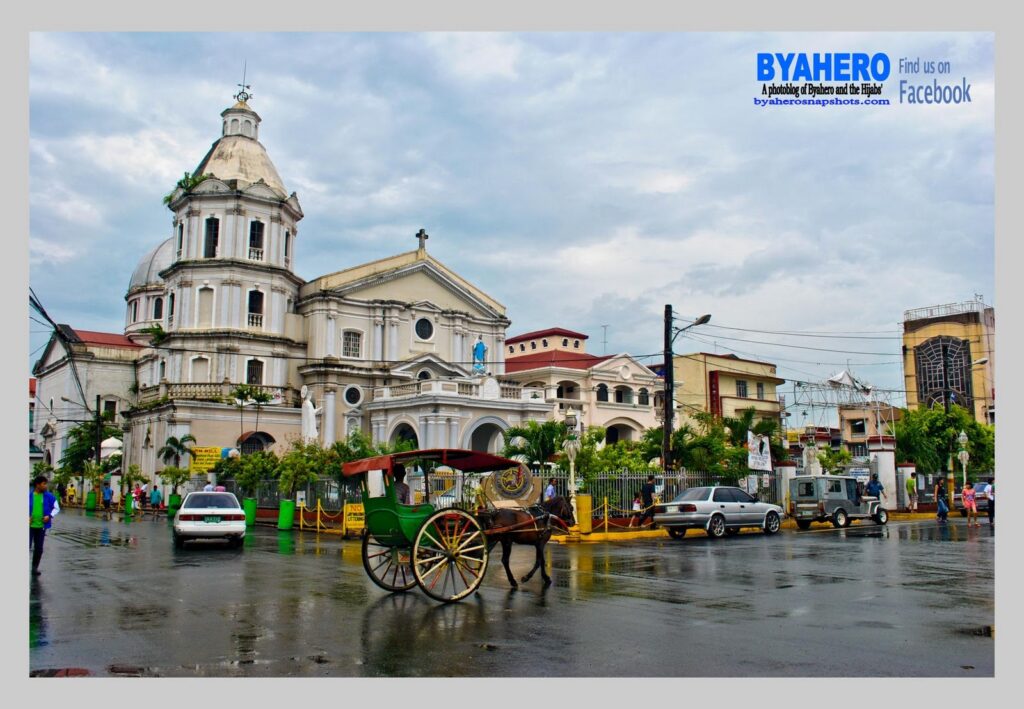
History of San Fernando
In 1754, The city of San Fernando started in the townships of Bacolor and Mexico. A year later in 1755, The first church was constructed with walls made of wood and nipa roofing. The municipal tribunal was established a year later; the first gobernadorcillo who served was Don Vidal de Arrozal.
After his service and retirement as gobernadorcillo, Don Ángel Pantaleon de Miranda went to Barrio Saguin in 1796, from where he began establishing his hacienda in Barrio Culiat.
December 8, 1829, the barrio parted from San Fernando as the new town of Angeles, with its new name Los Santos Ángeles Custodios,
A request to transfer Bacolor to San Fernando as the Provincial capital of the province of Pampanga was sealed on August 6, 1852.
And on the 11th of September 1881 under the Real Cedula 745, the request of transferring the province’s capital from Bacolor to San Fernando was approved and signed. However, the said allocation would not materialize.
In 1878, there were plans made to establish the town of Calulut. This new town would be consisting of Calulut and the adjacent barrios of Bulaun, Malpitic, Sindalan, La Paz, Lara, Saguin, Telabastagan, Balete, Malinao, Pulung Bulu, Panipuan, Macabacle, and the caserio of Pau in San Fernando, and Panipuan, Acle, Suclaban and the sitio of Gandus in Mexico. This proposal did not materialize due to strong disapproval from the parish priest of San Fernando.
On September 1, 1896, the town of San Fernando was in a state of war regardless of having a peaceful environment. On December 2, Brigadier General Diego De los Rios arrived in San Fernando to pacify the rebellion that began on August 30 in the Country’s capital Manila. To maintain the harmony in San Fernando, General Ruiz Serralde preempted Rio’s position as the Governor-General.
All people representing all towns of Pampanga except Macabebe were brought together in San Fernando on June 26, 1898, to pledge their loyalty to General Maximino Hizon who was at that time, the military Governor and the representative of Former President Emilio Aguinaldo.
The Philippine military forces commanded by General Antonio Luna burned and destroyed the casa Municipal, churches, and several houses on May 4 1899 in order to make them unusable to the advancing American troops.
Under the authority of Aguinaldo, he led the Filipino army in the Battle of San Fernando because of its Strategic location of San Fernando. The plan to retrieve the town wasn’t successful as the town of Calulut was taken by the American forces on August 9.
The Pampanga provincial administration was finally relocated to San Fernando from Bacolor on August 15, 1904, under Act No. 1204 signed on July 22, 1904. This was during the tenure of Governor Macario Arnedo and Municipal President Juan Sengson.
The Minalin town was once a part of San Fernando in 1904. Later on in 1909, Minalin reclaimed its political sovereignty.
Under the virtue of Act 1208 on January 2, 1905, the town of Santo Tomas was merged with San Fernando.
In 1941, the Japanese Imperial Army captured the town and established the municipal government under its administration. In 1942, thousands of Filipino and American Forces and Prisoners of war marched from Bataan to the San Fernando Train Station in what we all know in our history as the Bataan Death March.
The town of Santo Tomas separated in 1952 from San Fernando.
In 1990, Former Philippine President Corazon C. Aquino commenced the Paskuhan Village, the first Christmas village in Asia and the 3rd Christmas Village in the world. In 1991, Mount Pinatubo exploded after over 600 years of inactivity, throwing a layer of ash and volcanic debris on San Fernando town.
Barangay of San Fernando
The City of San Fernando is divided into 35 Barangay.
| Alasas | Baliti | Calulut | Bulaon | Dela Paz Norte |
| Dela Paz Sur | Del Carmen | Del Pilar | Del Rosario | Dolores |
| Juliana | Lara | Lourdes | Maimpis | Magliman |
| Malino | Malpitic | Pandaras | Panipuan | Pulung Bulo |
| Santo Rosario (Pob) | Quebiawan | Saguin | San Agustin | San Felipe |
| San Isidro | San Jose | San Juan | San Nicholas | San Pedro Cutud |
| Santa Lucia | Santa Teresita | Santo Niño | Sindalan | Telabastagan |
Festivals
Fiestang Tugak (Frog Festival)
One of the most unique and exotic festivals in the Philippines. Frog festival is a way of celebrating Fernandinos and the abundance of farm frogs in San Fernando. The Frog festival is held around October to November
Sinukwan Festival
The Sinukwan Festival demonstrates the Kapampangans’ passion for fun. It consisted of a week-long celebration featuring a big street dance every December. They dance to the accompaniment of the song “Atin Cu Pung Singsing” while wearing colorful costumes. Every year, the Save Pampanga Movement organizes the said festival, which is held in memory of Aring Sinukwan, the god of the Kapampangans in ancient times.
Ligligan Parul (Giant Lantern Festival)
Ligligan Parul means “lantern showdown.” It is an annual lantern-making competition that took place in San Fernando. Each Barangay of San Fernando must work together to build a giant lantern representing their Barangay. The lantern or parol is a traditional Filipino decoration that represents hope and light during the time of Christmas.
San Pedro Cutud Lenten Rise
One of the most religious festivities in the Philippines can be found in Pampanga. It’s the San Pedro Cutud in San Fernando, Pampanga. It features the re-enactment of the life and death of Christ, which includes the nailing of the hand on the cross. In this way, devotees’ ways of repenting their sins. The festivity happens every year, on Good Friday during Holy Week.
Place to see in San Fernando
Monumento Fernandino
The monument expresses the 4 characteristics of the Fernandino: 1.) the penitent girl with a lantern, 2.) the lady with the torch, 3.) the lady making the offering, and 4.) the boatman. The Monumento Fernandino is a sculptured masterpiece that pays homage to San Fernando’s interesting memoir and cultural custom that was built on February 4, 2004 (dedicated by Mayor Rey B. Aquino).
The San Fernando Train Station
The San Fernando Philippines National Railways (PNR) Station is a non-operational station in San Fernando City, Pampanga. It started working operationally in 1982, with one of its most prominent commuters known as our National Hero, Jose Rizal. This station was also formerly used to transport Filipino and American prisoners of war during the Bataan death march in 1942.
The now-defunct station is now converted as the Bataan Death March Museum and the City Tourism Office.
Pampanga’s Eye
Locally known as the “Pampanga’s Eye” it is the highest and biggest Ferris wheel in the Philippines. Located in Sky Ranch Pampanga near SM City Pampanga. The Ferris wheel or the “Big wheel “is sixty-five meters in height and fifty meters in diameter
The Metropolitan Cathedral
The Metropolitan Cathedral of San Fernando, also formerly called the Cathedral of Our Lady of the Assumption, is a neo-classical church located in San Fernando City, Pampanga, the church was wrecked by fire two times, the first was during the Philippine Revolution Army on May 1899 and the next one was in 1939. It was reconditioned by Architect Fernando H. Ocampo in 1948 and was canonically established on June 25, 1975.
Megaworld’s Capital Town
Capital Town is located in the heart of the City of San Fernando in Pampanga. Capital Town is scheduled to develop the newest central business ward in the north
Lazatin House
A notable historical house located in the city of San Fernando, Lazatin House is a well-known landmark that parades stunning colonial design. It was constructed on Consunji Street and was on one occasion inhabited by General Masaharu Homma. in the mid-1920s. Today, the ownership of this architectural landmark still belongs to the Lazatin family and is still regularly visited by travelers who are engrossed in its rich history
Municipio de San Fernando
Municipio de San Fernando is frequently pertained to as the City Hall of San Fernando located in the province’s capital, which is considered a cultural heritage site of Pampanga. The original city hall was constructed in the present-day location in 1755 made out of rocks and a thatched roof. It was burned, destroyed, and reconstructed during the Spanish, Japanese, and American colonization. The current day façade and the interior of the City Hall were fully reconditioned during the tenure of Former City Mayor Rey B. Aquino in 2003.
Heroes Hall and Heroes Park
The Heroes Hall functions as an expansion of the office from the City Hall. the Heroes Hall also houses the Offices of the Clerk of Court. Outside the Heroes Hall, several shrines of prominent individuals are created. The Heroes Park is part of the Heroes Hall Complex and houses shrines of Filipino and Kapampangan national heroes.
Other Important places in San Fernando
Heritage Houses:
- Hizon-Singian House (A. Consunji Street, Barangay Santo Rosario)
- Henson-Hizon House (V. Tiomico Street, Barangay Santo Rosario)
- Lazatin House (A. Consunji Street, Barangay Santo Rosario)
- Dayrit-Cuyugan House (MacArthur Highway, Barangay Dolores)
- Consunji House (A. Consunji Street, Barangay Santo Rosario)
- Tabacalera House (A. Consunji Street, Barangay Santo Rosario)
- Hizon-Ocampo House (A. Consunji Street, Barangay Santo Rosario)
- Santos-Hizon House (A. Consunji Street, Barangay Santo Rosario)
- Pampanga Hotel (A. Consunji Street, Barangay Santo Rosario)
- Archdiocesan Chancery (A. Consunji Street, Barangay San Jose)
Industrial Heritage Structures and Sites:
- San Fernando Train Station (Barangay Santo Niño)
- PASUDECO Sugar Central (Capitol Boulevard, Barangay Santo Niño)
- PASUDECO Staff Houses and Commissary (Capitol Boulevard, Barangay Santo Niño)
- San Fernando Water Reservoir (Barangay Lourdes)
- The Sugar Pugons (Greenville Subdivision and Barangay Quebiawan)
- Calulut Train Station (Barangay Calulut) – heavily damaged by informal settlers
- Baluyut Bridge (Gen. Hizon Avenue, Barangay Santo Rosario)
- The Arcaded Shop Buildings of Consunji Street – 1950s (Barangay Santo Rosario)
- Lantern Factories – Several lantern factories can be visited in Unisite Subdivision, Barangay Del Pilar, as well as in Barangays Santa Lucia, San Jose and Dolores.
References:
*https://en.wikipedia.org/wiki/San_Fernando,_Pampanga
*https://www.lamudi.com.ph/journal/tourists-guide-san-fernando-pampanga
*https://nhcphistoricsites.blogspot.com/2011/10/lazatin-house.html
*https://en.wikipedia.org/wiki/San_Pedro_Cutud_Lenten_Rites#/media/File:Cutud_Lenten_Rites.jpg
*https://en.wikipedia.org/wiki/Municipio_de_San_Fernando
*For corrections or commentaries, please email us at whereinpampanga@gmail.com





